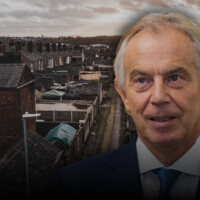There is a palpable sense of shock in the wake of Donald Trump’s reelection as demoralized populations (not only in the United States) realize that you can “just do things”. As Trump’s administration makes moves to restore various kinds of borders, from the biological to the geographical, now is a good moment to look back upon the past decade and ask: what happened? How did entire populations become so afraid to speak—in many cases, to challenge authority or to state simple truths?
No doubt there will be conflicts to come—not least between Christian conservatives and the Promethean tech right over what values America should hold: family, flag and faith or an unlimited future that seeks the stars over God and tradition? The tensions between a spiritual apprehension of the world, and a materialist and rationalist one that has no love for older truths are apparent. But one hopes, at the very least, that such tensions between tradition and futurism will be good-natured and held out in the open, and that the kinds of silencing tactics we have seen in use over the past decade—petitioning employers to sack people, defamation, violent threats, and so on—will be seen as the sadistic and anti-social tactics they are, and not be pursued by people who disagree with one another, no matter how vehemently. One hopes for a world in which people will simply be able to get on with it, where politics does not take the place of personality, and where culture of all kinds thrives.
Enjoy independent, ad-free journalism - delivered to your inbox each week
But there must be a reckoning, and an understanding of what has just happened, even as the difficulty of writing a history of the present becomes clear. Here I want to focus on one set of ideas and practices that appears, at least for the moment, to be in retreat: this is “anti-fascism” or those who organize under the banner of “Antifa”, who have, in recent years, taken to the streets—often masked and wearing black—in order to burn cities (BLM, when at least nineteen people died and over $1 billion damage occurred), protest Israel (the Gaza protests and occupations), oppose anyone who defends sexual difference (so-called “TERFs”), and to repeatedly and hysterically denounce Trump, other populist leaders and random citizens who disagree with them, as “fascist” or “Nazi”. In one sense, it is bizarre that this movement exists—after all, Italian and German fascism was defeated by 1945, and there have since been no explicitly fascist governments.
In any case, whether the accusation of “fascism” is a reference to the only historical horizon these activists can imagine, or whether by it they simply mean “person or view we are allowed to hate and destroy”, the term has become bastardized and overused to the point of absurdity. Liberal excesses of these kinds were no doubt a part of the reason why Trump got reelected: anti-fascists felt and continue to feel that what they are fighting is a real and present danger, and in order to stop the “far-right” (why no one is ever simply “right” is a mystery), nothing is off the table.
But why have citizens been allowed, even encouraged, to operate in this way against other citizens? Governments, after all, have laws against violent threats and an ever-increasing array of prohibitions on “hate speech” and “protected characteristics”. There’s no obvious sense in which an extra-judicial, non-governmental organization (or idea, depending on who you ask) needs to exist: if there are individuals or groups threatening other individuals or groups, the state ought to be able to handle these threats using existing laws.
At the same time, anyone can differentiate themselves an “anti-fascist”, even though in reality we are all anti-fascist (or post-fascist) subjects, insofar as fascism was defeated eighty years ago, and we live in liberal democracies, where the rule of law and voting exist, and a plurality of viewpoints and religious beliefs are held in increasingly mixed societies. We may doubt that this neutral picture is really the case (see, for clear example, the accusations of “two-tierism” levelled at Keir Starmer, where it is clear that some groups have been over-punished and some less in order to uphold a particular political abstraction—in this case, multiculturalism).
And yet for years, and increasingly since Trump’s first election in 2016, a certain segment of society has seen fascism everywhere, from the government on down. Whether anarchist, communist, anti-capitalism, green or socialist, anti-fascists have operated as a kind of street enforcement army for the liberal progressive agenda, all the while pretending that they are radicals and outsiders. This is a neat trick of course, particularly if you want to recruit young people attracted to the idea that they’ve seen something wrong with the world that others have missed.
The organization of Antifa is loose, but no less real for that, and there are clearly dedicated organizers in various cities: Andy Ngo, in particular, has been documenting individuals and groups for years, often at severe risk to his own safety. Some, such as Park MacDougald, have reported on how the “largely decentralized network of agitators” represented by Antifa is “politically and financially supported by a vast web of progressive nonprofits, NGOs, foundations, and dark-money groups ultimately backed by big-money donors aligned with the Democratic Party”. MacDougald notes “Many of the professional agitators involved in lawbreaking are quite literally on the payroll of big-city political machines, or provide important services such as get-out-the-vote organizing and phone banking during low-turnout Democratic primaries.”
Some activists are surely motivated by money, ideologically glossing such payment by pretending to be the “good guy” taking down evil. Some vulnerable people may genuinely be frightened by the idea of zombie Nazis returning from the last century to take rights away from oppressed people: but the funders and the organizers, inciting extreme emotions in mobs, know very well what they are doing.
Antifa have no historical basis for their existence. Their moral view of the world, insofar as they have one, is that there are two groups of people in the world—good guys (them) and bad guys (“fascists”). They have no explanation for why anyone would be a fascist, beyond an amorphous kind of “hate” which simply emanates from the bad people. Antifa oppose dialogue (“no debate!”), reason (the bad guys are not to be spoken to, only physically attacked) and keep people around them, as well as citizens in general, in a state of generalized fear. Describing another member of the public as a Nazi or a fascist or far-right (a track Starmer uses too) is an open call to attack them for their views —after all, who could tolerate a world with such evil people within it? This is undeniably a terrifying image of the world, and of other people.
As Daniel Miller puts it:
Antifa is essentially a cult which has swelled to occupy key chokepoints in society. Organised around a mythos that presents itself as secular, but in truth describes a demonology, the movement attracts the same personality types that invariably populate cultic milieus and exacerbates their flaws, above all, the profoundly damaged and the severely misdirected.
In the midst of the BLM riots, in 2020, Trump tweeted that “The United States of America will be designating ANTIFA as a Terrorist Organization”. In response, the New York Times quoted Ruth Ben-Ghiat, a professor at New York University, equating “the left’ with “antifa” and suggesting that crackdowns by the “right” place the left/antifa in “impossible situations”. People in impossible situations tend to lash out: much of the rhetoric of the past decade has been to invoke the language of victimhood and oppression in order to justify all kinds of violence. It remains to be seen whether Trump will remember his promise to proscribe Antifa: in the wake of Trump’s latest victory, individuals identifying with the organization have gone quiet, retreating to swear on Bluesky, or doubling down on disastrous identitarianism (at least, this appears to be the strategy so far of the severely damaged Democrats).
Many people felt unable to speak out against Antifa tactics: they were worried they too would lose their jobs, or come under physical threat. It is, of course, precisely for this reason that Antifa, often working behind the scenes online as well as fronting on the streets, use such tactics. Is it too soon to suggested we say “used” instead of the present tense? Is Antifa an on-going threat, or is it over? Many have noted how, particularly compared to the January 6th protestors, there have been very few Antifa prosecutions, let alone banning of any Antifa cell or network. Are we about to see that change under Trump? Perhaps. What seems most pressing is an analysis of who Antifa were, what they did and who funded them.
In part two, I will look in more detail at the dark tactics of people who were given free rein to wage war against everyday people, and how these actions should be identified and shamed, the better for them never to return.




Comments (0)
Only supporting or founding members can comment on our articles.